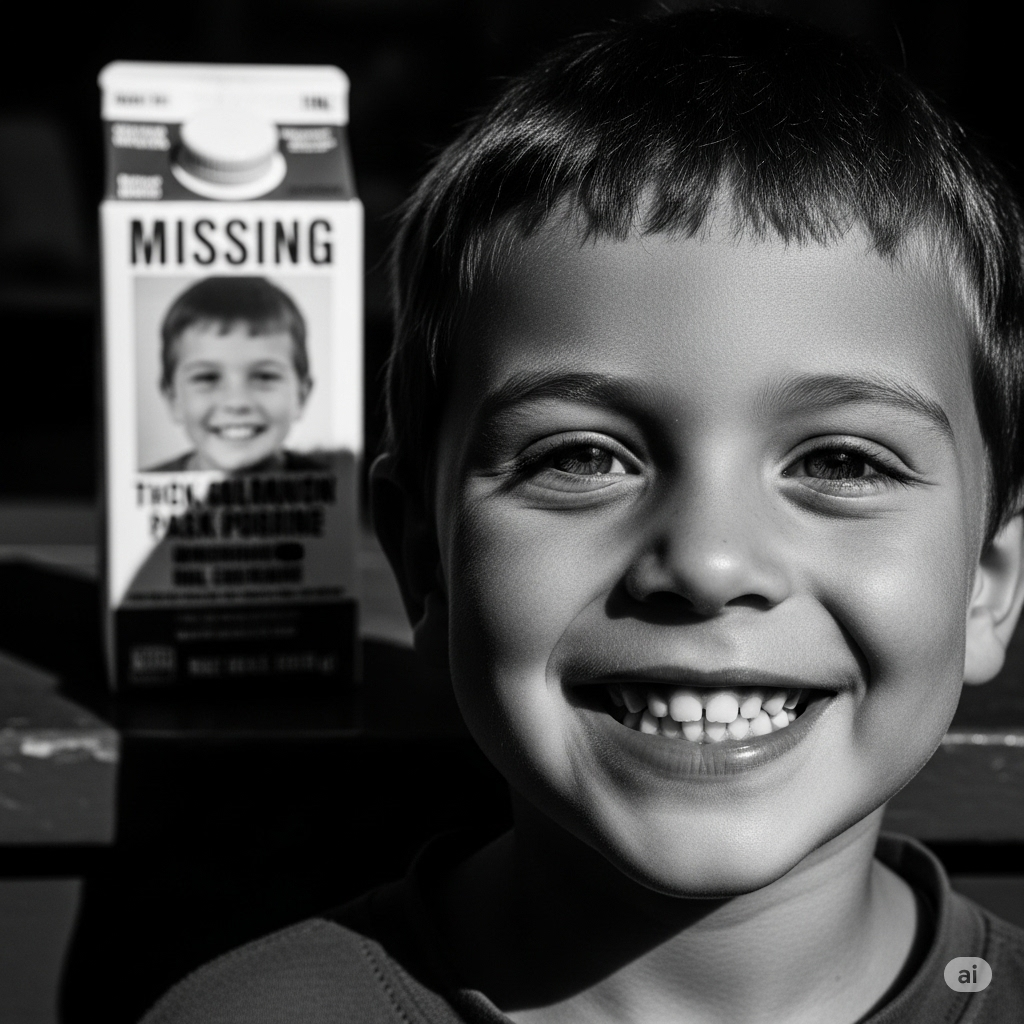Imagine it’s a quiet spring morning in New York City. The sun is rising, the streets smell faintly of coffee and car exhaust, and the city hums with its usual rhythm. Parents are rushing to work, kids are heading to school. Among them is a small blond boy, six years old, wearing a little cap and carrying a book bag nearly as big as he is. His name is Etan Patz.
He lives with his family on Prince Street in the SoHo neighborhood—back then, a gritty, industrial part of Manhattan filled with artists and old warehouses. Etan is excited, because this morning, for the very first time, he’s going to walk to the school bus stop by himself. It’s only two blocks away. He knows the route. He’s proud.
He says goodbye to his mom, waves, and walks down the sidewalk. He never makes it to the bus stop. He never comes home. And in the years that follow, Etan’s disappearance will haunt an entire nation, change the way America looks for missing children, and leave behind a mystery that took more than three decades to solve.
This is the story of the ghost of Prince Street—the story of Etan Patz.
The Morning He Vanished
It was May 25, 1979. Etan’s parents, Stan and Julie Patz, were ordinary New Yorkers raising their two kids in a loft apartment. Stan was a professional photographer, Julie a part-time teacher. Etan was their adventurous son—bright, polite, and a little independent.
That morning, Julie walked him to the door. She handed him a dollar so he could buy a soda at the corner store after school. Etan slung his blue book bag over his shoulder and headed out.
Neighbors later said they saw him walking down the street, turning the corner toward the bus stop at West Broadway and Prince. It was only two blocks away—a 2-minute walk. But by the time the bus arrived, Etan wasn’t there.
At first, no one panicked. Maybe he missed the bus. Maybe he went to a friend’s house. But when he didn’t come home that afternoon, panic set in. Julie called the school—they said Etan never showed up.
Within hours, police cars filled the street. Search dogs sniffed through alleys. Helicopters buzzed overhead. Volunteers plastered his picture on every light pole and storefront. But there was no trace—no witnesses, no screams, no clues. Etan had simply vanished into thin air.
The City in Shock
In 1979, New York City was already a tough place. Crime was high, fear was constant, and people didn’t trust strangers. But even in that world, a child vanishing in broad daylight was unthinkable.
Detectives searched abandoned buildings, subway tunnels, and the Hudson River. They questioned hundreds of people, from delivery men to local shop owners. Stan Patz printed thousands of posters using Etan’s school photo—a blond boy with a shy smile and bright blue eyes—and distributed them across the city.
That picture became famous. It was one of the first child photos ever printed on a milk carton, launching a national movement to help find missing kids. For years afterward, parents all across America would see Etan’s face at breakfast every morning.
But fame didn’t bring answers. The investigation went cold.
The Suspects
Over the years, detectives chased hundreds of leads. Some turned out to be well-meaning people with false memories; others were con artists trying to cash in on the family’s pain.
Then came the name José Ramos.
Ramos was a convicted pedophile who had been dating a woman who worked for the Patz family as a babysitter. He admitted knowing Etan, and he told police he had taken a boy who “looked like him” on the same day Etan disappeared. He claimed he “let him go,” but investigators doubted it.
In 1988, Ramos was imprisoned for unrelated crimes. Authorities declared him the prime suspect, but no physical evidence tied him to Etan. The Patz family, desperate for closure, filed a civil lawsuit against Ramos in 2004 and won. But Ramos never confessed.
By then, Etan’s parents had endured decades of heartbreak. His room remained frozen in time—his toys, drawings, and little clothes untouched. Every year on May 25, Julie lit a candle in the window.
The case had become part of New York’s history—a legend whispered through the city like a ghost story.
A New Lead
Then, in 2010—more than thirty years later—a new tip came in. A man named Pedro Hernandez, living in New Jersey, told relatives that he had done something terrible when he was young.
Hernandez had once worked at a small grocery store near the bus stop where Etan disappeared. According to his story, he had lured Etan into the basement with the promise of a soda, strangled him, and put his body in a box. He said he left the box in a dumpster.
Police couldn’t believe it. After so many false leads, could this finally be the truth? They reopened the case.
The Confession
In 2012, detectives brought Hernandez in for questioning. He was quiet, polite, and deeply religious. When asked about Etan, his eyes filled with tears. Then he confessed.
He told investigators he had been 18 years old, working part-time at the bodega. He saw Etan walking alone, offered him a drink, and led him to the basement. “I grabbed him by the neck and choked him,” Hernandez said. “He went limp.”
It was a confession that stunned everyone. But there was a problem: there was no physical evidence. No DNA. No fingerprints. No body.
Could they believe him? Or was he just another person seeking attention, guilt, or redemption?
Hernandez had a history of mental illness. His family said he often imagined things. But he also knew details that weren’t public—the layout of the old store, the timing, the weather.
For the first time in decades, it seemed the case might finally be solved.
The Trial
In 2015, the trial began. Stan and Julie Patz, now elderly, sat in court listening as Hernandez repeated his story. He spoke softly, describing how he “didn’t mean to hurt” the boy, how he “panicked,” how he “just wanted to forget.”
The jury couldn’t reach a verdict. A mistrial was declared.
Two years later, the case was retried. This time, prosecutors argued that Hernandez’s confession matched the facts too well to be coincidence. The defense argued that he was mentally unstable and had been manipulated by police.
The tension was unbearable. After nine hours of deliberation, the jury returned. Hernandez was found guilty of murder and kidnapping.
He was sentenced to 25 years to life in prison.
The Aftermath
The verdict didn’t bring joy—only relief. For the Patz family, it wasn’t closure, but it was something.
Stan Patz told reporters, “After all these years, we finally know who did it.”
But not everyone agreed. Many legal experts and even former detectives believe Hernandez’s confession may have been false, the result of coercion or mental instability. Without evidence, the debate continues.
To this day, some believe José Ramos was the true killer. Others think Etan’s body was buried beneath the foundations of a nearby building. But no proof has ever been found.
The Legacy of Etan Patz
Etan Patz’s disappearance changed America. It exposed how easily children could vanish in a big city and how little infrastructure existed to find them.
His case led to the creation of the National Center for Missing and Exploited Children. It inspired the milk carton campaign, Amber Alerts, and missing-child posters in every police station.
May 25—the day Etan vanished—was officially declared National Missing Children’s Day in the United States.
Etan’s story became a warning, a reminder, and a tragedy that shaped generations. Parents began walking their kids to bus stops again. Neighborhoods formed watch groups. America learned a new kind of fear: the fear of the stranger.
The Ghost of Prince Street
Today, Prince Street looks very different. The once-gritty lofts are now luxury apartments. Cafés line the corners. Tourists stroll by, taking photos of trendy shops. But if you look closely, you’ll see a small bronze plaque on the sidewalk.
It reads simply:
Etan Patz, 1972–1979. May 25, 1979. Still Missing.
People walk past it every day, unaware of the tragedy that began there. But locals know. They call him the ghost of Prince Street.
Sometimes at dusk, when the streetlights flicker on, they say you can almost feel him there—a little boy with a blue backpack, waiting for the school bus that never came.
The Unanswered Questions
Even now, so many questions linger. Why was there never a body? Why were there no witnesses? Why did it take 33 years for anyone to confess?
Perhaps the most haunting question of all is this: if Pedro Hernandez truly did it, why did he confess after so many years? Was it guilt? Madness? Or the weight of a secret too heavy to carry?
We may never know for sure.
What we do know is that Etan Patz’s story forced an entire country to open its eyes—to the dangers, the vulnerabilities, and the value of every missing child.
And though decades have passed, his story hasn’t faded. It lives on, like a whisper carried through the streets of SoHo, a voice that still asks the same question over and over again:
Where is Etan?
Closing Thoughts
For a generation of Americans, Etan’s name became a symbol—a reminder that even in the brightest morning sunlight, shadows can still fall. His story is a ghost story, but not one of spirits or monsters. It’s about loss, about a mystery that changed the world, and about a family that never stopped hoping for the truth.
Etan Patz left home one sunny morning in May, smiling and full of excitement, walking toward his future. Somewhere between his front door and the corner bus stop, the world lost him.
And even now, more than forty years later, we’re still looking.




